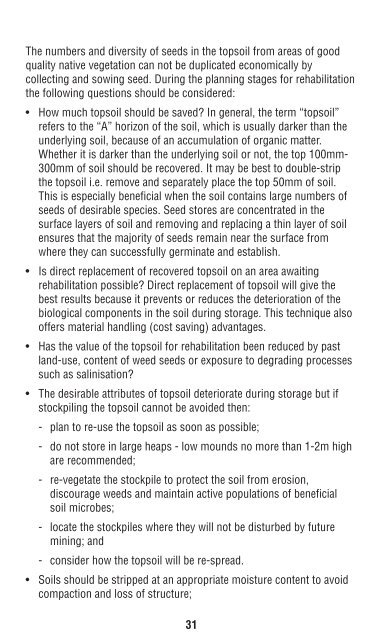Mine Rehabilitation Handbook - Mining and Blasting
Mine Rehabilitation Handbook - Mining and Blasting
Mine Rehabilitation Handbook - Mining and Blasting
You also want an ePaper? Increase the reach of your titles
YUMPU automatically turns print PDFs into web optimized ePapers that Google loves.
The numbers <strong>and</strong> diversity of seeds in the topsoil from areas of good<br />
quality native vegetation can not be duplicated economically by<br />
collecting <strong>and</strong> sowing seed. During the planning stages for rehabilitation<br />
the following questions should be considered:<br />
• How much topsoil should be saved? In general, the term “topsoil”<br />
refers to the “A” horizon of the soil, which is usually darker than the<br />
underlying soil, because of an accumulation of organic matter.<br />
Whether it is darker than the underlying soil or not, the top 100mm-<br />
300mm of soil should be recovered. It may be best to double-strip<br />
the topsoil i.e. remove <strong>and</strong> separately place the top 50mm of soil.<br />
This is especially beneficial when the soil contains large numbers of<br />
seeds of desirable species. Seed stores are concentrated in the<br />
surface layers of soil <strong>and</strong> removing <strong>and</strong> replacing a thin layer of soil<br />
ensures that the majority of seeds remain near the surface from<br />
where they can successfully germinate <strong>and</strong> establish.<br />
• Is direct replacement of recovered topsoil on an area awaiting<br />
rehabilitation possible? Direct replacement of topsoil will give the<br />
best results because it prevents or reduces the deterioration of the<br />
biological components in the soil during storage. This technique also<br />
offers material h<strong>and</strong>ling (cost saving) advantages.<br />
• Has the value of the topsoil for rehabilitation been reduced by past<br />
l<strong>and</strong>-use, content of weed seeds or exposure to degrading processes<br />
such as salinisation?<br />
• The desirable attributes of topsoil deteriorate during storage but if<br />
stockpiling the topsoil cannot be avoided then:<br />
- plan to re-use the topsoil as soon as possible;<br />
- do not store in large heaps - low mounds no more than 1-2m high<br />
are recommended;<br />
- re-vegetate the stockpile to protect the soil from erosion,<br />
discourage weeds <strong>and</strong> maintain active populations of beneficial<br />
soil microbes;<br />
- locate the stockpiles where they will not be disturbed by future<br />
mining; <strong>and</strong><br />
- consider how the topsoil will be re-spread.<br />
• Soils should be stripped at an appropriate moisture content to avoid<br />
compaction <strong>and</strong> loss of structure;<br />
31<br />
• Is enough topsoil available for rehabilitation? The appropriate depth<br />
of topsoil will depend on the site. Approximately 200-300mm of<br />
replacement soil is desirable where over-burden material is not toxic<br />
to plant growth. If adverse conditions exist, topsoil may need to be<br />
increased <strong>and</strong> other measures to isolate toxic material considered<br />
(refer section 6.0).<br />
• Where there are only limited supplies of topsoil then sensible<br />
compromises may need to be made by:<br />
- Identifying priority areas. These are likely to be:<br />
* those areas most prone to erosion (lower end of slopes,<br />
embankments, etc); or<br />
* locations where the physical <strong>and</strong>/or chemical characteristics of<br />
the overburden are adverse to plant growth (e.g. saline, alkaline<br />
or acid spoils etc); or<br />
* arid areas; or<br />
* those areas that accumulate water (e.g. contour benches<br />
<strong>and</strong> berms).<br />
- Top soiling (<strong>and</strong> re-vegetating) in strips.<br />
- “Borrow” topsoil. Stripping adjacent areas not scheduled for<br />
mining can, in some cases, be justified (e.g. to sheet toxic<br />
material), but it is generally not recommended since rehabilitation<br />
of the borrow area must be considered.<br />
- Import topsoil from other mining sites. This is generally not<br />
economical but may be possible in some circumstances. care is<br />
required to ensure weed species are not introduced.<br />
- Trial plant species <strong>and</strong> surface treatments for direct re-vegetation<br />
of overburden material. Less rapid re-vegetation may be an<br />
acceptable trade-off on non-priority areas so as to achieve rapid<br />
re-vegetation of critical areas by using all available topsoil.<br />
- Can the topsoil be augmented with other material? An “underlay”<br />
of subsoil with reasonable properties for plant growth will produce<br />
better results than a thin layer (0.1m) of topsoil alone. Although<br />
not always possible, as a general guide avoid placing subsoil or<br />
overburden material near the surface if it:<br />
* is excessively s<strong>and</strong>y; or<br />
* is excessively clayey (especially if mottled in appearance,<br />
indicating poor drainage); or<br />
32
















